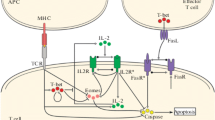Abstract
This paper presents an analysis of the global physical properties of an idiotypic network, using a growth model with complete dynamics. Detailed studies of the properties of idiotypic networks are valuable as one the one hand they offer a potential explanation for immunological memory, and on the other have been used by engineers in application of AIS to a range of diverse applications. The properties of both homogeneous and heterogeneous networks resulting from the model in an integer-valued shape-space are analysed and compared. In addition, the results are contrasted to those obtained using other generic growth models found in the literature which have been proposed to explain the structure and growth of biological networks, and also make a useful addition to previous published results obtained in alternative shape-spaces. We find a number of both similarities and differences with other growth models that are worthy of further study.
Preview
Unable to display preview. Download preview PDF.
Similar content being viewed by others
References
Barabasi, L., Albert, R.: Emergence of scaling in random networks. Science 286, 509–512 (1999)
Bersini, H.: Self-assertion vs self-recogntion: A tribute to francisco varela. In: Proceedings of ICARIS 2002 (2002)
Bersini, H.: Revisiting Idiotypic Immune Networks. In: Banzhaf, W., Ziegler, J., Christaller, T., Dittrich, P., Kim, J.T. (eds.) ECAL 2003. LNCS, vol. 2801, pp. 164–174. Springer, Heidelberg (2003)
Bersini, H., Lenaerts, T., Santos, F.: Growing biological networks: beyond the gene duplication model. Journal of Theoretical Biology (2006)
Brede, M., Behn, U.: The architecture of idiotypic networks: Percolation and scaling behaviour. Physical Review E 64(1) (2001)
Brede, M., Behn, U.: Patterns in randomly evolving networks: Idiotypic networks. Physical. Review E (2003)
Carneiro, J., Coutinho, A., Stewart, J.: A Model of the Immune Network with B-T Cell Cooperation. ii - the Simulation of Ontogenesis. Journal of Theoretical Biology 182, 531–547 (1996)
Farmer, J.D., Packard, N., Perelson, A.: The immune system, adaptation and machine learning. Physica D 22, 187–204 (1986)
Hart, E.: Not all balls are round: An investigation of alternative recognition-region shapes. In: Jacob, C., Pilat, M.L., Bentley, P.J., Timmis, J.I. (eds.) ICARIS 2005. LNCS, vol. 3627, pp. 29–42. Springer, Heidelberg (2005)
Hart, E., Ross, P.: The impact of the shape of antibody recognition regions on the emergence of idiotypic networks. International Journal of Unconventional Computing (2005)
Jeong, H., Mason, S., Barabsi, A., Oltavi, Z.: Lethality and centrality in protein networks. Nature 411, 41–42 (2001)
Jerne, N.K.: Towards a network theory of the immune system. Annals of Immunology (Institute Pasteur) (1974)
Lenaerts, T., Bersini, H., Santos, F.: How scale-free type-based networks emerge from instance-based dynamics. In: Proceedings of 10th ALife Conference (2006)
Neal, M.: Meta-stable memory in an artificial immune network. In: Timmis, J., Bentley, P.J., Hart, E. (eds.) ICARIS 2003. LNCS, vol. 2787, pp. 168–180. Springer, Heidelberg (2003)
Newman, M.E.J.: The structure and function of complex networks. Society for Industrial and Applied Mathematics Review 45(2), 167–256 (2003)
Takumi, K., De Boer, R.: Self assertion modeled as a network repertoire of multi-determinant antibodies. Journal of Theoretical Biology 183, 55–66 (1996)
Varela, F., Coutinho, A.: Second generation immune network. Immunology Today 12(5), 159–166 (1991)
Vasquez, F., Flamimi, A., Maritan, A., Vespignani, A.: Modelling interaction of protein interaction networks. Complexs 1, 38–44 (2003)
Watanabe, Y., Ishiguro, A., Shiraio, Y., Uchikawa, Y.: Emergent construction of a behaviour arbitration mechanism based on the immune system. Advanced Robotics 12(3), 227–242 (1998)
Author information
Authors and Affiliations
Editor information
Editors and Affiliations
Rights and permissions
Copyright information
© 2006 Springer-Verlag Berlin Heidelberg
About this paper
Cite this paper
Hart, E. (2006). Analysis of a Growth Model for Idiotypic Networks. In: Bersini, H., Carneiro, J. (eds) Artificial Immune Systems. ICARIS 2006. Lecture Notes in Computer Science, vol 4163. Springer, Berlin, Heidelberg. https://doi.org/10.1007/11823940_6
Download citation
DOI: https://doi.org/10.1007/11823940_6
Publisher Name: Springer, Berlin, Heidelberg
Print ISBN: 978-3-540-37749-8
Online ISBN: 978-3-540-37751-1
eBook Packages: Computer ScienceComputer Science (R0)




